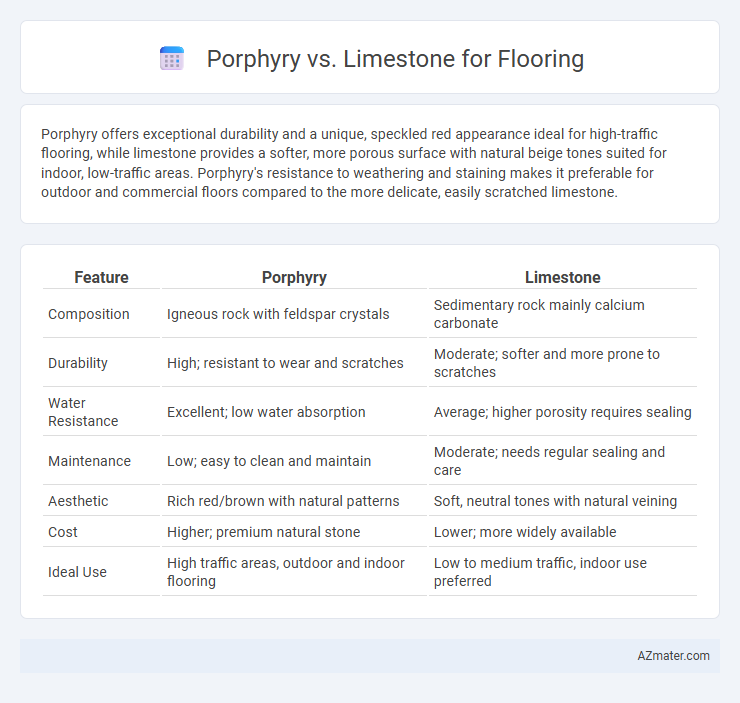Porphyry offers exceptional durability and a unique, speckled red appearance ideal for high-traffic flooring, while limestone provides a softer, more porous surface with natural beige tones suited for indoor, low-traffic areas. Porphyry's resistance to weathering and staining makes it preferable for outdoor and commercial floors compared to the more delicate, easily scratched limestone.
Table of Comparison
| Feature | Porphyry | Limestone |
|---|---|---|
| Composition | Igneous rock with feldspar crystals | Sedimentary rock mainly calcium carbonate |
| Durability | High; resistant to wear and scratches | Moderate; softer and more prone to scratches |
| Water Resistance | Excellent; low water absorption | Average; higher porosity requires sealing |
| Maintenance | Low; easy to clean and maintain | Moderate; needs regular sealing and care |
| Aesthetic | Rich red/brown with natural patterns | Soft, neutral tones with natural veining |
| Cost | Higher; premium natural stone | Lower; more widely available |
| Ideal Use | High traffic areas, outdoor and indoor flooring | Low to medium traffic, indoor use preferred |
Introduction to Porphyry and Limestone Flooring
Porphyry flooring features a durable, volcanic igneous rock known for its rich red and purple hues and high resistance to wear, making it ideal for heavy-traffic areas. Limestone flooring offers a softer, sedimentary stone characterized by its neutral tones and natural veining, which provides a classic and elegant appearance. Both materials fulfill distinct architectural needs with porphyry excelling in robustness and limestone favored for its aesthetic warmth.
Key Properties of Porphyry
Porphyry flooring excels due to its exceptional hardness, high durability, and resistance to wear, making it ideal for high-traffic areas. Its unique igneous texture offers low porosity and superior frost resistance compared to limestone, which is softer and more prone to erosion. Porphyry's natural variegated colors and fine-grained crystalline structure contribute to both aesthetic appeal and long-lasting performance in indoor and outdoor flooring applications.
Key Properties of Limestone
Limestone flooring is prized for its natural durability, neutral color palette, and ease of polishing, making it a versatile choice for both traditional and modern interiors. Its porous structure requires proper sealing to resist moisture and staining, but provides excellent thermal insulation and a smooth, comfortable surface underfoot. Compared to porphyry, limestone offers a softer texture and more consistent appearance, ideal for spaces seeking a warm, inviting atmosphere.
Durability Comparison: Porphyry vs Limestone
Porphyry is significantly more durable than limestone, offering exceptional resistance to wear, scratching, and heavy foot traffic due to its igneous volcanic origin and dense crystalline structure. Limestone, a sedimentary rock, is softer and more porous, making it prone to erosion, chipping, and staining when used as flooring material. For high-traffic areas requiring long-lasting and low-maintenance flooring, porphyry provides superior longevity compared to the more fragile and maintenance-intensive limestone.
Aesthetic Differences: Color and Texture
Porphyry flooring showcases rich, deep reds and purples with a distinctive granular texture, providing a luxurious and dramatic appearance ideal for high-end interiors. Limestone features softer, neutral tones such as beige, cream, and light gray, combined with a smooth, matte surface that creates a calming and timeless aesthetic. The color vibrancy and coarse texture of porphyry contrast sharply with limestone's understated elegance and fine-grained finish, influencing the overall ambiance of the space.
Maintenance Requirements for Each Stone
Porphyry flooring requires minimal maintenance due to its high hardness and resistance to wear, making it ideal for high-traffic areas with periodic sweeping and occasional sealing to preserve its natural color. Limestone, being a softer and more porous stone, demands regular cleaning with pH-neutral products and more frequent sealing to prevent staining and surface etching. Both stones benefit from immediate spill cleanup, but limestone's vulnerability to acidic substances necessitates vigilant upkeep to maintain its appearance over time.
Slip Resistance and Safety Considerations
Porphyry flooring offers superior slip resistance due to its naturally rough and textured surface, making it an excellent choice for high-traffic and outdoor areas where safety is paramount. Limestone, while aesthetically pleasing with its smooth finish, tends to be more porous and can become slippery when wet, necessitating additional treatments or finishes to enhance grip. For environments prioritizing slip safety, porphyry provides a more reliable, durable flooring option with inherent anti-slip properties.
Cost Comparison: Installation and Long-Term Value
Porphyry flooring typically has a higher installation cost compared to limestone due to its hardness and the specialized tools required for cutting and setting. Limestone offers lower upfront expenses but may incur higher maintenance costs over time because of its softer, more porous nature. Porphyry provides greater long-term value with superior durability and resistance to wear, making it a cost-effective choice for high-traffic areas despite the initial investment.
Environmental Impact and Sustainability
Porphyry flooring offers superior durability and requires less frequent replacement, reducing long-term environmental impact compared to limestone, which is softer and more prone to wear. Limestone quarrying often leads to significant habitat disruption and higher carbon emissions due to intensive processing, whereas porphyry's extraction is less invasive relative to its hardness. Choosing porphyry enhances sustainability by minimizing resource consumption and supporting longer lifecycle flooring solutions.
Best Applications for Porphyry and Limestone Flooring
Porphyry flooring excels in high-traffic commercial and outdoor areas due to its extreme durability, resistance to weathering, and unique, rich color variations that enhance aesthetic appeal. Limestone flooring is ideal for residential and interior spaces where a softer, warm, and natural look is desired, benefiting from its ease of maintenance and ability to be honed to a smooth finish. Both materials offer distinct advantages: porphyry suits rugged environments requiring long-lasting surfaces, while limestone fits elegantly in controlled, low-impact settings prioritizing comfort and style.

Infographic: Porphyry vs Limestone for Flooring
 azmater.com
azmater.com